#shoujo manga history
Explore tagged Tumblr posts
Text
A short Takemiya Keiko interview from 1998
My "All Things Takemiya" detective friend, Platypus, provided me with a two-page Takemiya Keiko interview scanned by @97tears from the now discontinued Hato yo! (鳩よ! - Oh, Pigeons!) magazine. It was a literary magazine published between 1983 and 2002—a publication you probably wouldn't look at if you were searching up on Takemiya, ig.
You can see the Japanese original taken from the 1998 April issue of the magazine, and my (poor) translation of it under the cut.
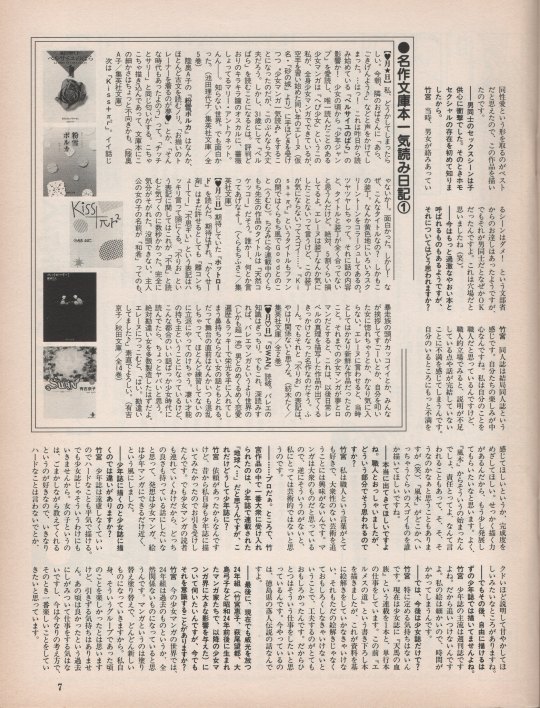
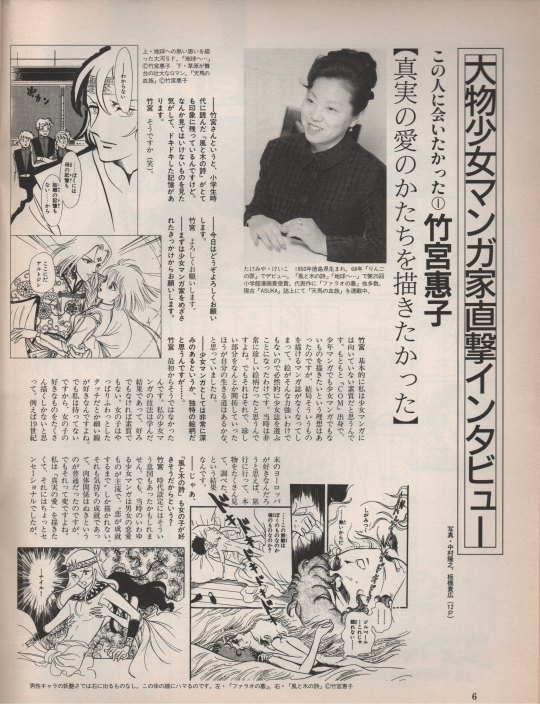
Takemiya Keiko Interview from issue #4 of Hato yo (1998)
An interview with a master mangaka herself!
I’ve always wanted to meet them! 1 – Takemiya Keiko
“I wanted to draw real love”
Takemiya Keiko. Born in Tokushima in 1950. Debuted with “Ringo no Tsumi” in 1968. Won the 25th Shogakukan Manga Award with “Kaze to Ki no Uta” and “Terra e.” Representative works include “Pharaoh no Haka” among others. “Tenma no Ketsuzoku” is currently being serialized in Asuka Magazine.
I read “Kaze to Ki no Uta” during elementary school. It has left a very deep impression on me. I remember that when Ms. Takemiya is mentioned. It was like I was looking at something I was not supposed to look, and I still remember the thrill I felt. Takemiya: Oh, is that so? (laughs)
Thank you so much for being with me today. Takemiya: And thank you for having me.
Shall we start with what prompted you to become a shoujo manga artist? Takemiya: Fundamentally, I was not suited for shoujo manga. I debuted in COM, and my dream was to draw manga that was neither shounen nor shoujo. But alas, the magazine in which I could draw my ideal manga was no more. My style didn’t have much “power” in it, so I inevitably had to choose a shoujo manga magazine. I think my art style was really uncommon at the time. But it was what it was, and I thought to myself, maybe capitalizing on that was the path I should take.
Your works have an extraordinary depth as far shoujo manga goes... They have a unique art style... Takemiya: It hasn’t always been like that. My shoujo manga technique was the fruit of what I have studied. It was not a result of my personal taste, nor my innate skills. Girls like that feathery, light touch. They like fine lines. But I didn’t have any of those. So, I figured drawing things girls would like a lot was my only choice. For instance, when I thought how they must like Europe at the end of the 19th century, I went on a trip as a result. I saw the real thing at its source, and did research on it.
Then was Kaze to Ki no Uta born because you thought girls would like it? Takemiya: That might have played into my choice of the time period the story’s set in. However, romance stories between a boy and a girl was the norm in shoujo manga at the time. You could only draw “And they lived happily ever after...” stories. And that happiness was only on the emotional level. It was normal to exclude all physical contact. But that is simply “affection.” I wanted to draw “real love.” I admit it was a little too sensational, but I thought doing it through same-sex love was the best way to go about it. That’s how I drew Kaze to Ki no Uta.
The sex scenes between men were quite a shock for me as a little child. That’s how I learned homosexuality existed. Takemiya: At the time, there was an official notice published by the Ministry of Education that stipulated that “You shall not draw a boy and a girl getting intimate!” However, if it was two boys, things were somehow fine... I thought I’d found a loophole! (laughs)
These days, there are more extreme books labeled as “yaoi.” What do you think about them? Takemiya: At the end of the day, doujinshi are doujinshi. They focus on personal enjoyment of a group. I consider myself a “craftsman,” and if I look at it from a craftsman's standpoint, I am not wholly satisfied with how they leave many things unexplained, or how they have no conclusion. At their level, I’d liked if those artists too felt more dissatisfied... If they aimed to be more conclusive. They have the talent to draw, so I’d love them to polish those skills. I’m sometimes told that it all started with “Kazeki,” and that I must take responsibility. And every time, I think to myself, “Oh... Re-really? Dit it?” (laughs) I wish someone drew something so awesome that it would blow Kazeki out of the water...
I’d love that too! You called yourself a “craftsman,” but what exactly makes you think so? Takemiya: I really love the word “craftsman.” I’m not interested in trying to reach an ideal of art that would not resonate with the public. I believe manga is something aimed at the general public. Otherwise, I would not consider it to have artistic value.
Spoken like a real pro... Which brings me to Terra e... I think that’s the most widely-accepted manga of yours by the general public, and it was published in a shounen magazine. Why is it the outlier to be published in a shounen magazine? Takemiya: I received an offer for it, but the truth is, I had always wanted to draw for a shounen magazine. That’s why accepted. But I needed to draw in the shoujo manga audience too, so I wanted the story to offer the best for both demographics. So I tried to have the concept to be that of shoujo manga, and the style to be that of shounen manga as much as possible.
Is it different to draw for a shounen manga magazine, and a shoujo manga magazine? Takemiya: You don’t have to hold back in shounen magazines. It fine to draw more hardcore stuff. But in shoujo magazines, that’s out of the question. There’s a trend that dictate that you should explain things in long-winded ways and spoil the reader, because girls like it when you reveal things to them through subterfuge, so don’t hit them directly with hard stuff.
But after that, you’ve never drawn for shounen magazines which allowed you to draw as you wished. Takemiya: Shounen magazines are mostly weekly. I cannot keep up with that. My art has fine details, so it takes me a lot of time to draw.
Then will you be solely drawing for shoujo magazines in the future? Takemiya: I can’t really say that I will. I’m currently working for a shoujo magazine with “Tenma no Ketsuzoku”, and with volume releases. I recently released an illustration book titled “Hermès no Michi.” I needed to base myself on documents and explain them in drawings. And they couldn’t be any kind of drawing, they needed to be interesting. Trying to come up with ways to do that was a very fun experience. So for starters, I’d like to undertake a work like that again. That kind of work I’m working on right now is a story about the fugitives of the Heike Clan in Tokushima.*
*T/N: She is referring to “Heian Joururi Monogatari.”
To finish our interview off, I’d like ask a question about the Year 24 Group (shoujo manga artists born around the 24th year of the Shouwa Era like Takemiya Keiko, Hagio Moto, and Ooshima Yumiko, who have influenced the shoujo manga world in the following years) which is still very prominent: Are you still conscious of it? Takemiya: Year 24 is a thing of the past in the modern manga scene. I think it’s irrelevant now. Manga is evolving, becoming something else after being painted over continuously. I had fun when I was part of that group, but I don’t feel like dragging it out. I don’t want to cling to nice memories of the past as I work, and want to focus on how I currently think and feel. I want to do what I think is most fun at the moment.
#takemiya keiko#keiko takemiya#竹宮 惠子#24年組#year 24 group#interview#hato yo!#鳩よ!#shoujo manga history#manga history#kaze to ki no uta#風と木の詩#takemiya keiko interview#yaoi
134 notes
·
View notes
Text
Loved reading this post!
Western literature and shoujo manga.
If you're, like me, someone whose passion is old shoujo manga, you may have noticed that at least one or more of your favorite mangaka has written manga adaptations of famous American and European novels. But why ?
According to this essay by Kawabata Ariko and Murakami Riko, in the early 20th century, because there was no Internet, people had no choice but to rely on big bookstores to learn more about and to purchase foreign novels. It was therefore not common to read them. The Iena bookstore, located in Ginza, was a rare indie bookstore that sold art-related foreign books and, while unfortunately, the store has closed today, many shoujo mangaka remember going there often to look for reference material amongst foreign works.



Alice in Wonderland, Daddy Long Legs and Heidi translated in Japanese with covers by Setsuko Tamura in the 80s.
This other essay by Oogushi Hisayo states that foreign novels were only broadly introduced in Japan for young girls in the 30s. Famous girls' magazines (which are to be differentiated with shoujo magazines) such as Shoujokai (created in 1902), Shoujo no Sekai (created in 1906) and Shoujo no Tomo (created in 1908) started introducing Western literature in their issues from the 1930s to the 1940s. Works such as "The Little Princess", "Heidi", "Little Women", "Daddy Long Legs" and more were published in these girls' magazines, making them more known to the Japanese audience and resulting in shoujo manga adaptations in the following years.

Little Women illustrated by Nakahara Junichi in the Girls' magazine Shoujo no Sekai.
Three works in particular seem to have gained a lot of popularity in the 40s: "Little Women" by Louisa May Alcott, "Heidi" by Johanna Spyri and "Anne of Green Gables" by Lucy Maud Montgomery. All three are coming of age stories of young girls, and all three have one theme that seems to stand out: family. In the aftermath of WW2, many Japanese lost their families and many young children became orphans. In such times, novels that showcased happy families comforted Japanese readers. The popularity of these three works did not end in the 40s though, since in the 70s and 80s, all three got their 50 episodes anime adaptation in the Calpis Gekijou series (also known as World Masterpiece Theater), which, by the way, I highly recommend watching.
It is to be noted that these three works also became popular because they showcased independent and developed female leads, which has since then become a staple of shoujo manga itself, regardless of genre.
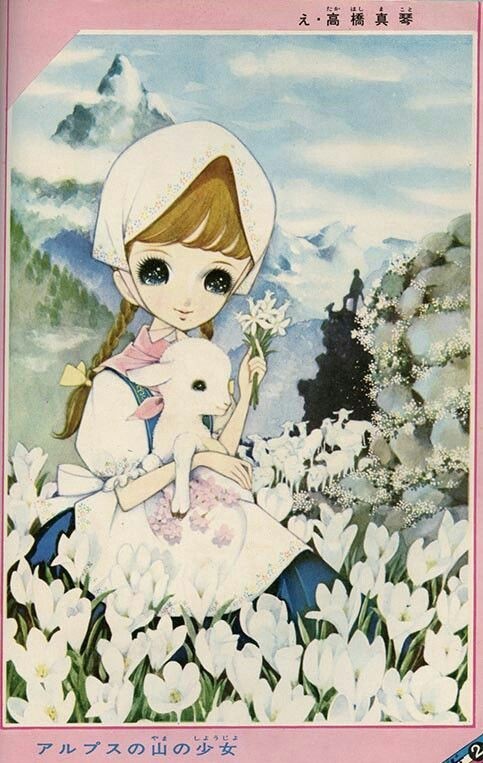


Heidi by Macoto Takahashi, Anne of Green Gables by Sakamoto Midori (1977) and Heidi by Watanabe Masako (1966).
In the 70s, a few mangaka published works that reminded critics of the "Bildungsroman". The Bildungsroman is a literary genre born in the 1800s in Germany, and it is a sub-category of the coming-of-age story. The Bildungsroman stands out from regular coming-of-age stories by focusing on the psychological and moral growth of its protagonist. Examples of that would be Moto Hagio with The Heart of Thomas in 1974 and Takemiya Keiko with Kaze to Ki no Uta in 1976 (though she never intended to write a Bildungsroman). The West was still shown in a more traditional version in these works, as both stories take place in old catholic boarding schools.
Similarly to how Audrey Hepburn, a Hollywood actress, was seen as a fashion leader in Japan (more about that on my other post about her influence on shoujo), Japanese people at the time had an idealized view of the West and anything from the Western world seemed fashionable and trendy. A great example of that is Sanrio. If you look at early Sanrio characters, a lot of them are from the West: Hello Kitty is British, the Little Twin Stars were inspired by Christmas, My Melody by the little red riding hood, Jimmy & Patty are American etc.
This view of the West began to shift in the 80s and the western literature that inspired shoujo mangaka started to change as well. Instead of comforting, idyllic stories about family life in a traditional American or European country side or stories taking place in traditional European catholic schools, manga inspired by more realistic and contemporary works started publishing. For example, Banana Fish by Akimi Yoshida (1985) draws inspiration from "A Perfect Day for Bananafish" by J.D. Salinger and two of Hemingway's works: "The Snows of Kilimanjaro" and "Islands in the Streams". All three of these focus on either modern issues like overconsumption or darker themes like death and loneliness. The change can also be seen in the gender and age of the protagonists. Instead of being about young teen girls that shoujo readers could identify with, Banana Fish is about adult men. The inspiration is also a lot more loose, and instead of an adaptation, there are only references to J.D. Salinger and Hemingway's works throughout the manga.
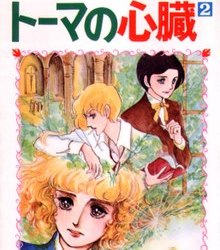

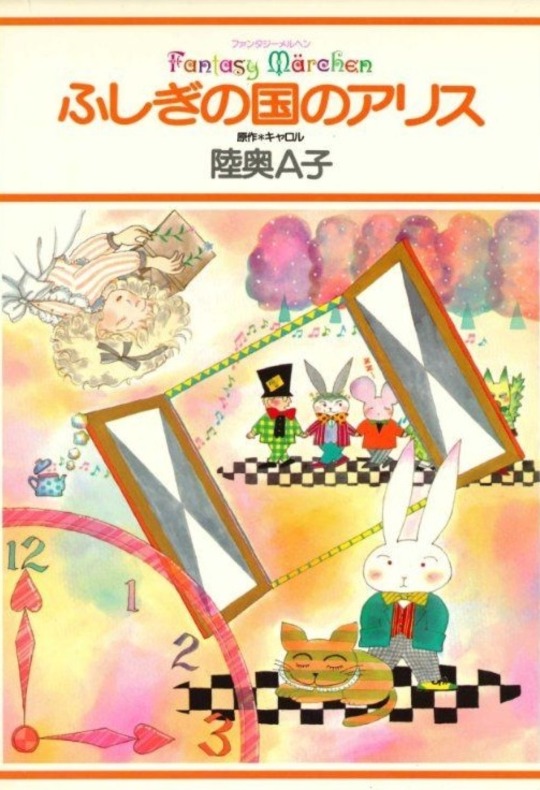
The Heart of Thomas by Moto Hagio (1974), Banana Fish by Akimi Yoshida (1985) and Alice in Wonderland by Mutsu A-ko (1983).
To conclude my post, I really wanted to include this line from the essay by Oogushi Hisayo: If America (can apply to the West as a whole) was once the backdrop of stories for those who yearned to read about "somewhere that is not here", it has, from the 80s onward, become the backdrop of stories for those who yearned to read about "the now and here".
312 notes
·
View notes
Text





Sort of manga for the 20th year anniversary of the magazine belonging to the team behind Otaku festival, soon to be published. One of the oldest trees, in the Romanian capital city, almost burned down around 4 years ago, leaving behind a hollow inside. Ever since the incident, a piece of metal is strapped to its side, turning it into an occasional refuge for the homeless. This is the roughly translated version, the printed one is in Romanian.

The alt manga is about the spirit of a world living on the outskirts, almost forgotten by the hijacked revolution's aftermath. To look forward, this homeless grandfather keeps in mind the words of Lena Constante as well as the old-survivor-tree's lessons of life.
☯︎ This December marks 35 years since the Revolution of 1989, back when Ceaușescu's dictatorship ended. Nationalism, coupled with nostalgia for the by-gone Communist era, alongside homophobe outbursts and pro-extreme right Legionari fanatics have bombarded our everyday scrollable realities and, according to some, almost lead to a second Mineriad. Meanwhile, the presidential elections've been rescheduled for spring 2025.
♗♤🃟Gonna end this post and the year with a reminder to support causes such as the Innitiative Group defending the I.O.R. Park and independent journalists such as the guys at Snoop, tracing the tangled web behind our chaotic Romanian political life.
#trees#tree#old trees#survivor series#ecology#ecosystem#bucharest#botanical garden#natural history#ancestry#comix#comics#romania#grandparents#black and white#biodiversity#biodiversidad#comicstrip#indigineous people#revolution#december 1989#escher#raster#dambovita#by the river#alt manga#shōjo manga#shojo manga#shoujo
34 notes
·
View notes
Text
Is it just me or is villainess isekai low key the best genre?
27 notes
·
View notes
Text


I completely forgot about this Seiran lore the first time I watched this and wow. It’s so much. Are Rei and Fukiko uniquely toxic (yes I mean in the end they are sisters LOL) but are they also simply the product of an environment that champions suicide as the only alternative to heterosexual marriage/leaving Seiran (also yes!!!)
#oniisama e#grace watches oniisama e#god I wish I could find the article that talked about the history of shinju (double suicide) as it relates to lesbian relationships#and shoujo manga#that I read in college#it kills me
22 notes
·
View notes
Text



fall 2024 anime 🍂🇯🇵🎬🤗
status: currently watching
#manga#light novel#anime#blue box#re zero season 3#nina the starry bride#you are ms. servant#365 days to the wedding#yakuza fiance#natsume's book of friends#dandadan#i'll become a villainess who goes down in history#shoujo#shonen#josei#seinen#japan#japanese
26 notes
·
View notes
Text
OSCANDRÈ❤️❤️❤️
⚠️THIS IS NOT MINE!⚠️ ->@paleosart

A fan art of Oscar François de Jarjayes and Andrè Grandier by @paleosart from the manga "Versailles no Bara" or "Lady Oscar- The Rose of Versailles" by Riyoko Ikeda
#year 24 group#oscarxandré#oscandré ship#oscandré#oscar x andré#lady oscar#andré grandier#andré x oscar#andréxoscar#andre grandier#riyoko ikeda manga#riyokoikeda#ikeda riyoko#riyoko ikeda#french revolution#révolution française#histoire française#history of france#historical manga#histoire#history#historical shojo#shojo manga#shojo#vintage shoujo#classical shoujo#shoujo anime#shoujo manga#shoujo#queen marie antoinette
32 notes
·
View notes
Text




I made a bunch of these because I have no chill. I think this series is super fucking cute and I love that it comes with an official playlist.
One of my favorite things about this manga, other than the adorable characters and the alternative lifestyle, is honestly...the BACKGROUND. I love that it's neon green! It's such an interesting stylistic choice, but somehow, it works perfectly. There's not a lot to say about the plot of this story because it's fairly straightforward: a girl becomes interested in a guy due to his coolness and their mutual love of rock music, and not only do they both discover the real person underneath their personas, they both develop new friendships with people who are newer to the alternative scene. All of the characters help each other find a safe place to enjoy music, to break through their fears of being judged, and the leads still fall in love with a girl without in-text homophobia being the major obstacles. I love the choice to have Aya and her friends be glitter-glamor gyaru's, an alternative subculture in their own right! I love that we get to see Narita become good friends with Mitsuki and that he completely supports (ships) them. I love Kanna and Joe's relationship still being amicable and fond despite their breakup. I love that Chizuru and Mao came to see why Aya had an interest in rock. I love that we get to see how gender non-conformity in young girls is treated. I love that Mitsuki's current crowd accepts her completely. I love the little parallel between Aya and Mistuki feeling left out; or the parallel of Mitsuki and Joe pulling away while consumed by writing music. I love that music drives all of them to seek out unique friendships. I just. Love how important music is to this story, as a huge music fan myself.
I decided to reread this because I just have so much fun with it. It's a GL/Shoujo Ai that I would 100% recommend!
*Sorry about the text quality in the middle two. The songs listed are: All I Think About Now by Pixies (Mitsuki's side) and Talk by Beabadoobee (Aya's side). The song listed at the bottom is Fell in Love with a Girl by The White Stripes. I left out the artist because I wanted to use a cute font.
#i was inspired (just a bit) by that post about the gl fandom history in the us/uk being a result of tamen de gushi's#popularity and how it (along with a few others) has opened up the scene here#which has given us this great manga!#the guy she was interested in wasn't a guy at all#tgswiiwagaa#media and art#fan art#digital collage#lexi's post#mine.img#manga recommendation#girls love#shoujo ai#my fandoms
13 notes
·
View notes
Text
I love them so much in this manga❤️... they're so sweet and they look so cute and good together there🥹🫶🏻 I would really love to see an anime based on this manga❤️
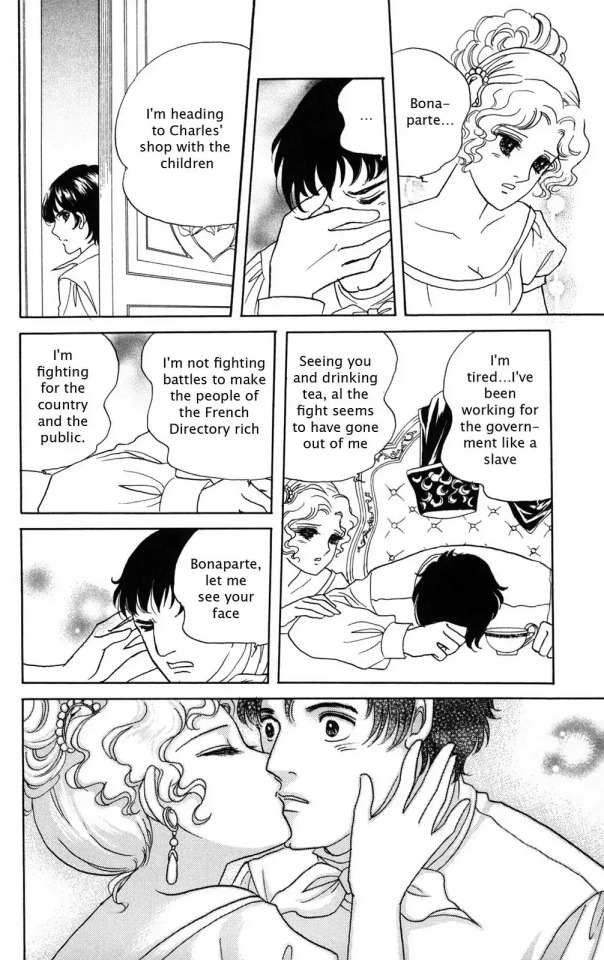

Manga: Josephine the French Rose/ Bara no Josephine- Yumiko Igarashi
Characters: Napoleon Bonaparte and Josephine de Beauharnais
#shojo manga#manga#shojo#shoujo manga#shoujo#yumiko igarashi#yumiko igarashi manga#rose#napoleon#napoleon bonaparte#josephine#bara no josephine#josephine the french rose#josephine de beauharnais#history#historical manga
21 notes
·
View notes
Text
Where it all started...
Platypus, the preserver of manga history, showed this page he scanned from a 1978 issue of Monthly Manga Shounen (月刊マンガ少年) to me. It was great seeing a manga artist, Minamoto Tarou, acknowledged the importance of Fire! even back then, and hailed it as the grandmother of the 70s bishounen manga.
Here's a quick translation for you.
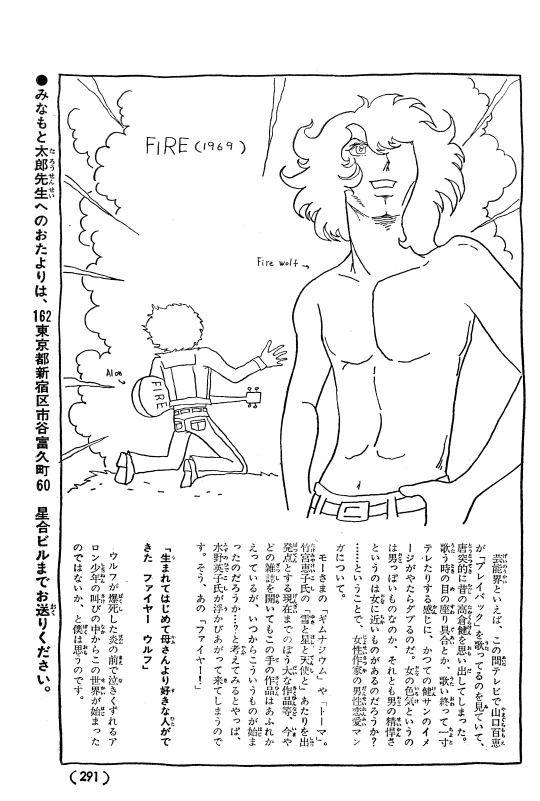
Monthly Manga Shounen, issue no. 1978/8
Minamoto Tarou
Speaking of show business, when I was watching Yamaguchi Momoe sing “Playback” on TV the other day, I was suddenly reminded of Takakura Ken’s youth. Her dreamy gaze when she sings, how she looks slightly bashful when her song ends... She was almost the spitting image of Ken-san of the past. Is it that there’s something "manly" in a woman’s charm? Or does a man’s masculinity has something akin to femininity? ...And it brings me to the topic of male-male romance manga drawn by women. Things took off after manga like Mo-sama’s “Gymnasium” or “Thomas”, and Takemiya Keiko-shi’s “Yuki to Hoshi to Tenshi to.” And until now, there has been a plethora of works in that vein, and every magazine you pick up today sure to be full of such works. But when did it really start? When I think about it, Mizuno Hideko-shi shines bright. Yes, I'm talking about “Fire!” “For the first time in my life, I loved someone more than I did my mother: Fire Wolf.” Didn’t this whole world came to be in young Aaron’s cries as he was breaking down in tears before the flames of the explosion that killed Wolf? This is what I think.
**Insert fangirl squee here!**
#hideko mizuno#mizuno hideko#水野英子#fire!#ファイヤー!#minamoto tarou#tarou minamoto#みなもと太郎#manga shounen#マンガ少年#retro manga#vintage manga#retro BL#vintage BL#70s manga#60s manga#manga history#shoujo history
26 notes
·
View notes
Text
Audrey Hepburn and Shoujo Manga.
Something I wish more people talked about when discussing the history of shoujo manga is the influence of Audrey Hepburn. There are unfortunately very few sources in English aside from the shoujo manga Wikipedia page that cites Sabrina as the first romcom movie that inspired the emergence of romcom as a genre in shoujo.
I found this interesting japanese article about the history of shoujo manga that says (translation is mine so it may not be perfectly accurate): "[Audrey Hepburn's] dark hair and petite, slender figure made her appearance closer to that of a japanese, unlike other more glamorous looking foreign actresses. Her looks, paired with outfits made by Givenchy, quickly made her a fashion leader in Japan."


According to this article, the manga "Ojousan Tantei Series" (1958~1961) by Imamura Tsutomu & Imamura Yoko (father and daughter) used Hepburn as inspiration for the fashion worn by the main character.
The article also names Mizuno Hideko as a shoujo mangaka inspired by Hepburn, who made a manga adaptation of a Roman Holiday in 1966. According to this other blog, Mizuno's adaptation (originally published in an issue of Ribbon Magazine) didn't face copyright issues on release day but as time passed and copyrights became more strict, it was never printed again. That is, until 2007, when the copyright for the film expired and the manga adaptation was published in its own copy (as shown below).


And of course I can't not mention that it is also one of Mizuno Hideko's manga adaptations, this time of Sabrina under the title "Suteki na Cola", that is cited on Wikipedia as the first shoujo romcom.


There are other shoujo mangaka who were clearly inspired by Hepburn like Tani Yukiko (most obvious in her fashion illustrations and her various illustrations of Hepburn) and Chikae Ide who made a manga adaptation of Green Mansions following the release of the movie, which starred Hepburn (and Tani Yukiko made the cover for that adaptation..!)
Audrey Hepburn's legacy is truly impressive and, chances are, without her remarkable popularity amongst japanese teen girls at the time, the shoujo romcom as we know it today may have only been popularized later !
#shoujo history#vintage shoujo#retro shoujo#a roman holiday#audrey hepburn#50s manga#60s manga#mizuno hideko#tani yukiko#chikae ide#shoujo#sabrina#60s#50s#manga history#shojo#shojo manga
202 notes
·
View notes
Text
Whoops, realized I forgot to post it! But here's the Rose of Versailles article
By including New Heloise in the manga, Ikeda is making the claim that romance stories have both personal and political power. She argues that romance novels are read by and deeply move people of all social classes, political inclinations, and genders. Romance novels can start radical conversations and can tell oppressed people they are worthy of love and respect regardless of their social status. If serious revolutionary philosophers like Rousseau wrote romance novels which helped provide the spark for the French Revolution, then shouldn’t we also take shoujo manga seriously as a form of political criticism as well?
29 notes
·
View notes
Text
I'm bored...
Here
An unabridged guide yuri history
Yuri yuri yuri yuri. Cute girls being gay, my beloved. But where does it come from?
Before the yuri we know and love today, there was Class S. Class S, also known as S kankei, is a subset of Japanese literature that popped up at around early twentieth century. They showcased "affectionate friendship" between women.
These literature reflected the views of wlw relationships at that time, as something that is normal and natural for young girls to go through, but something they need to grow out of eventually. (It's just a phase mentality). Its roots can still be seen in present-day yuri (ahem sayaka's backstory).
All of this is just a backdrop for what came next.
We skip forward in time to the 1970s, when manga depicting homoeroticism began to popping up all around the place. This is the birth of our beloved yuri as we know today. All these early yuri works can be attributed to the Year 24 Group.
The Year 24 Group are not only responsible for yuri, but also yaoi and for revitalizing shoujo manga publishing in general. Their works were so influential that it brought shoujo manga into it's golden age.
What in the 50s and 60s was just simple stories marketed to young school girls became A LOT more complex and works begin to explore themes of psychology, gender, sexuality and whatnot. (They need an essay all to themselves, I will blab about them again when I'm bored maybe)
Some of the notable members of the Year 24 Group in regards to yuri would be Ryoko Yamagishi and Riyoko Ikeda. Ok, let's focus on Riyoko Ikeda alone for a sec, their most famous work, The Rose of Versailles, is set in pre-revolutionary France and is about Marie Antoinette and Oscar François de Jarjayes, and it is of course, very gay. Not the most relevant but thought it was interesting enough to plop it here.
After gaining a lot of popularity, yuri got itself its own magazine!!! Yuri Shimai was yuri anthology magazine, which ran only from June 2003 to November 2004. But it was succeeded by Comic Yuri Hime in July 2005. Which is still being serialized today! All of our beloved yuri (that isn't self-published) comes from this magazine.
Side Note: One of the first stories to be serialized in Comic Yuri Hime is kisses, sighs, and cherry blossom pink, written by Morinaga Milk. They deserve an essay to their own. I will most certainly gush about them in the near future. This is a warning.
Comic Yuri Hime got itself a sister magazine in Comic Yuri Hime S, which was targeted at a young male audience.. But it did not last long as it merged back with Comic Yuri Hime in 2010. The only reason I bring this up is because YuruYuri was serialised that magazine.
Which brings us to present da- Wait! Did we skip over something? We did! We forgot to mention the revolutionary girl herself, Utena Tenjou. Well, not necessarily forget. No words I can use can properly explain how influential Revolutionary girl Utena was and still is. Someone who is more of an Utena expert can cover it's speciality.
Which FINALLY brings us to present day, where yuri is still a relatively niche genre. But it has VERY dedicated fan base and idiots like me who write out it's history for funsies ^-^. There might even be a religion around it, who knows,,,
If you read through all of this... what is wrong with you?/lh.
#yuri#gl#girl's love#manga history#gay manga history#yuri history#shoujo ai#this was mostly written from memory (except for the names) for funsies (^.^)#yes. i memorized all of yuri history. this shouldn't be surprising in the least#consider this my application to be the yuri historian or something#this was written in an hour-ish so sorry for any weird grammar you may find#moral of the story#never let me be bored
17 notes
·
View notes
Text
Man one wouldn't think that a Reverse harem-y shoujo Manga without a tragedy tag could affect me so strongly, but welp.
Not in spite of these but because it uses it's tropes to cause maximum emotional damage.
While still being so self indulgent in it's suffering.
7 notes
·
View notes
Text

Fanarting again 🦅🌟paint .. ink .. etc.. don't know her! But anyway I love gay people and having free time
#hi izuru tokoro no tenshi#umayodo no ouji#shotoku taishi#shoujo manga#ryoko yamagishi#year 24 group#buddhism#japanese history#twinkified historical figure fanart lets fucking go!!!#lowkey been allergic to NOT drawing barn owls#my art#medieval history#hi izuru tokoro no tenshi fanart#日出処の天子#I'm so so excited for the new tr#asuka period#kofun period
3 notes
·
View notes
Text
youtube
It's the final manga news video of 2024 and I am so excited to talk about manga publishers sharing their "recaps" as well as SO much Haikyuu!! news!! 🤩
Plus, sharing my "struggles" of voting in the 2024 Shoujosei of the Year Awards, which is open NOW!
#manga community#manga cover#shoujo#manga recommendation#your forma#your forma anime#haikyuu#haikyu#haikyuu the dumpster battle#twisted wonderland#twisted wonderland manga#honey lemon soda#honey lemon soda manga#victoria of many faces#I’ll Become a Villainess Who Goes Down in History#love of kill#love of kill manga#Twisted Wonderland Episode of Scarabia#disney twisted wonderland#Magical Girl Dandelion#manga news#anime news#manga and anime#anime and manga#Youtube
2 notes
·
View notes